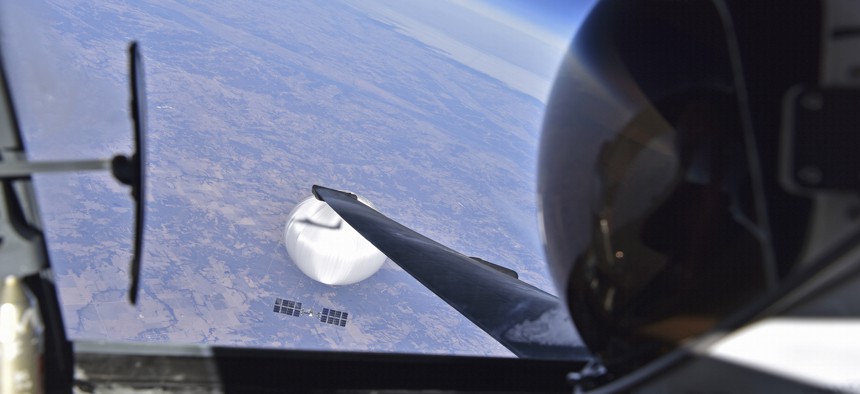TOM Z. COLLINA

Washington has an uncanny ability to make mountains out of molehills, exaggerate threats, and weaponize any situation into a crisis. It’s as if the Washington political scene thinks there are not enough problems in the world, so it needs to create some new ones. And the number one target for crisis creation right now, both on spy balloons and nuclear weapons, is China.
Take the recent spy balloon imbroglio. Yes, China launched a spy balloon that wound up crossing the United States, and no, we should not believe Beijing’s cover story that this was an innocent weather balloon. But that does not necessarily mean, as Sen. Marco Rubio, R-Fla., implied, that this was a Chinese plan to embarrass the United States: “It’s not just the balloon,” Rubio said. “It’s the message to try to send the world that America, ‘We can do whatever we want, and America can’t stop us.’”
Well, maybe China can’t do whatever it wants. According to weather analysis from the Washington Post, it appears that Beijing never intended the balloon to cross the United States at all. Weather models indicate that an unexpected cold front may have pushed the balloon north, away from its planned path, suggesting “that the ensuing international crisis that has ratcheted up tensions between Washington and Beijing may have been at least partly the result of a mistake,” the Post writes. CIA Director William Burns said that as to “when and what the Chinese leadership knew about the trajectory of this balloon, I honestly can’t say.”
And according to the New York Times, U.S. officials insist the Chinese balloon “did not retrieve any information that Chinese satellites and other intelligence assets cannot already collect.”
Unfortunately, it appears that the political brouhaha over the spy balloon led the Biden administration to overreact. Biden may have been justified in shooting down the balloon off the Carolina coast on Feb. 4, but it made little sense to cancel Secretary of State Antony Blinken’s visit to China that was planned for soon after. Ironically, that meeting was intended to reduce tensions between Washington and Beijing.
Then the Biden administration proceeded to shoot down three more unidentified objects over the next three days. Biden’s policy of “shoot first and ask questions later” looks overly aggressive now that it appears that these presumed balloons might not have been from China or posed any threat. As the president later said, the intelligence community’s current assessment is that these objects were most likely balloons tied to private companies, recreation, or research institutions. Efforts to recover the debris from two of these incidents have been abandoned.
Balloon threats are not the only ones getting inflated lately. In early February, the Wall Street Journal reported that the U.S. Strategic Command found that China now has more launchers (not missiles or nuclear warheads) for intercontinental ballistic missiles than the United States. Rep. Mike Rogers, R–Ala., the new chairman of the House Armed Services Committee, rushed to falsely claim that China is “rapidly approaching parity with the United States” in nuclear forces. “We cannot allow that to happen. The time for us to adjust our force posture and increase capabilities to meet this threat is now,” Rogers said. This is simply not true.
Yes, China is building several hundred new underground missile launchers, known as silos. But even if these launchers are complete (which is not clear, see here), most of them are empty; they are holes in the ground, containing neither missiles nor nuclear warheads. Moreover, the United States has many more nuclear warheads on ICBMs, submarines, and bombers than Beijing.
Bottom line: the United States today has well over ten times more nuclear weapons than China. It’s true (and concerning) that Beijing is building up, but even if you believe worst-case predictions, China’s nuclear arsenal will remain just a fraction of the size of the U.S. arsenal a decade from now. Increasing the U.S. arsenal in response is not only unneeded but counterproductive: it could provoke Beijing (and Moscow) to build up more.
In both the balloon and nuclear sagas, we are better off talking to Beijing to deflate tensions than getting tangled up in a new arms race. We need to better understand what China was trying to do with its errant balloon and why it is building up its nuclear force. But by jumping from concern to panic we create a toxic political environment that makes diplomacy impossible and conflict more likely. The Biden administration has yet to reschedule the cancelled meeting with China and the relationship has continued to go south as the two nations trade accusations about their spy networks. Washington and Beijing need more transparency, not less.
President Biden has rightly said he is “not looking for a new Cold War,” yet that is exactly what some hawks in Congress seem to want. But just as with the U.S.-Soviet cold war, an arms race with Beijing is not good for U.S. national security or the American people—and is not inevitable. We must create a more rational debate about real vs. imagined threats from China before we make our own worst fears come true.
No comments:
Post a Comment